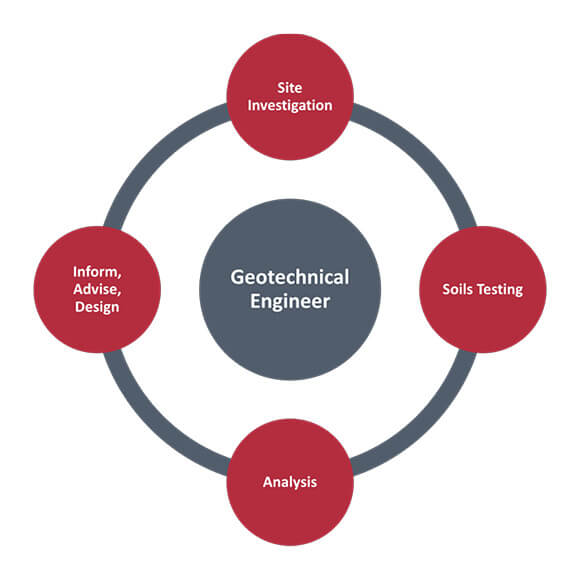Everything about Geotheta
Table of ContentsSome Known Factual Statements About Geotheta About GeothetaIndicators on Geotheta You Should KnowThe Greatest Guide To Geotheta
They work together with civil designers, architectural engineers, architects, and other experts to integrate geotechnical factors to consider right into the general project layout and construction procedure. This needs effective synergy, sychronisation, and communication to make sure that the geotechnical facets straighten with the project goals and meet regulative demands.Mining & Materials Design: Principles of boring, penetration prices, and elements affecting the selection of exploration technique. Characteristics of nitroglycerins, shooting systems and blast patterns. Blasting strategies in surface area and underground operations. Unique blasting methods at excavation perimeters. Vibration and noise control. Mechanical and constant techniques to fragmentation, consisting of longwall shearing and fullface boring.
Integrated analysis of fragmentation and comminution procedures. Used by: Mining & Materials Engineering.
Getting The Geotheta To Work
Bachelor's degree programs in civil, geotechnical, geological, and ecological design generally last four years and consist of basic education and learning training courses in English, social scientific research, and the liberal arts, along with programs in sophisticated mathematics, architectural geology, and liquid mineralogy. (https://www.find-us-here.com/businesses/Geotheta-Alexandria-Alabama-USA/34113488/)
Geotechnical design includes the analysis of the dirt and rock problems at a certain website, and their ramifications for the growth of that website. As most frameworks rely upon the ground for support, it lacks surprise that a thorough understanding of the ground problems, and the suitability of structure systems, are essential to the long-term security and performance of the building or structure.
Specialising in the investigation of geological developments and ground behaviour, geotechnical engineers perform clinical examinations and screening to comprehend the effect these geological developments might carry the style and building and construction of structure, civil and infrastructure jobs. This knowledge is critical for the design and building and construction of structures, roads, passages, dams, bridges, and supply of water and sewer system.
The geotechnical team at Douglas Allies consistently seek advice from architects, design designers, designers, and contractors to make recommendations on style and development propositions to make sure that the constructed structures are accordingly made for the ground conditions. As an example, the layout of footing systems requires to consider the weight of the framework, the ability of the ground to sustain that weight along with motion tolerances and reliable building.
All about Geotheta
This task is considerably streamlined by the use our Douglas Map geospatial platform which makes this information conveniently easily accessible in a simple to make use of internet browser interface. A geotechnical engineer will direct the drilling of boreholes and test pits to accumulate soil and other samples, and additionally evaluate surface functions and ground direct exposures to create a geotechnical design of the subsurface conditions.
Relying on the task kind and ground problems ran into, lab screening may among various other things evaluate toughness, compressibility, sensitivity and/or permeability of dirt and rock examples. Hereafter data is collected and collated, the outcomes are made use of for a geotechnical version of the website, which is commonly presented as areas throughout the site.

A geotechnical examination by nature can only examine the ground conditions at the places pierced or excavated. All-natural variants in dirt and rock problems can happen throughout a website and between test places. It is as a result good technique that the geotechnical designer be retained throughout building and construction of the task to read this give on-site verification that the ground problems experienced are regular with the assumptions and recommendations supplied in the geotechnical investigation record.
Examine This Report about Geotheta
Geotechnical designers use their thorough expertise of soil and rock to examine risk and address issues on varied framework projectsGeotechnical design is a specialist branch of civil design which looks at the practices of earth products and the application of dirt and rock mechanics. Consulting Engineers. As a geotechnical designer, you will assess the physical, mechanical and chemical residential properties of dirt and rock in order to develop structures, retaining frameworks and earthworks
Geotechnical engineering is very closely connected to and overlaps with, both design geology and ground engineering - https://packersmovers.activeboard.com/t67151553/how-to-connect-canon-mg3620-printer-to-computer/?ts=1722609175&direction=prev&page=last#lastPostAnchor. It's possible to specialise in geotechnics or help a geotechnical company however be understood as an engineering geologist or a ground engineer. As a geotechnical engineer, you'll need to: build and keep connections with customers and various other specialists included in the site, throughout each projectmaintain safety criteria on site be mindful of price implications when you make recommendationsstudy geological maps and airborne pictures from an array of resources and from different time periodsexamine construction intends to see just how practical they are based on your understanding of the siteinvestigate risks or geological hazards for the sitesearch for eco delicate attributes, such as garbage dump start to develop valid and expository ground modelsplan field investigationsdrill and evaluate samples of bedrock, soil, groundwater and added materials oversee other professionals on sitesolve technical problems as they occur, such as unexpected structures at drill sitesmonitor problems during and after building to make certain structures are steady in the brief and lengthy termadding data accumulated on website to your initial researchcreating geotechnical estimations, illustrations, and 2 or three-dimensional computer designs analyzing the datamaking recommendations concerning the suggested use of the website

 Jaleel White Then & Now!
Jaleel White Then & Now! Joseph Mazzello Then & Now!
Joseph Mazzello Then & Now! David Faustino Then & Now!
David Faustino Then & Now! Mason Reese Then & Now!
Mason Reese Then & Now! Robbie Rist Then & Now!
Robbie Rist Then & Now!